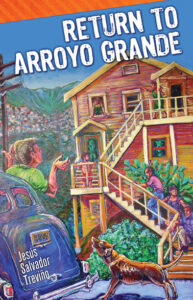 Treviño chosen as November 2015’s “Author of the Month” on Houston Public Media
Treviño chosen as November 2015’s “Author of the Month” on Houston Public Media
Houston Public Media radio host Eric Ladau interviewed Treviño for its website’s “Arte Público Press Author of the Month” feature, and along with the transcript, their conversation is available to listeners on the station’s interactive site through on-demand audio streaming here.
Click here to see all Arte Público authors featured on Houston Public Media.
About the Author:
JESÚS SALVADOR TREVIÑO is an award-winning filmmaker, known for his pioneering documentaries and feature films about the Chicano experience. He is the author of The Fabulous Sinkhole and Other Stories (Arte Público Press, 1995), The Skyscraper that Flew (Arte Público Press, 2005) and a critically acclaimed memoir, Eyewitness: A Filmmaker’s Memoir of the Chicano Movement (Arte Público Press, 2001).
About his latest book, Return to Arroyo Grande
 In the opening piece, “Where Lost Things Reside,” rumor has it that Old Man Baldemar has died. Stories about the old geezer’s demise abound: he died of pneumonia; he was hit by a car, even killed by the big C. All Yoli Mendoza knows is that she’s lost the income from helping the perverse recluse with his grocery shopping. Entering the house she has never been allowed in before, she’s shocked to find it’s much larger than it appears from the street. And even odder, it’s full of items, each tagged with a name, city and date. There’s a room full of cell phones, drawers packed with rings, trays and trays of plastic lids … socks, watches, wallets, glasses! Was Baldemar the caretaker of all of the things that have been lost, no matter the time, city or even country?
In the opening piece, “Where Lost Things Reside,” rumor has it that Old Man Baldemar has died. Stories about the old geezer’s demise abound: he died of pneumonia; he was hit by a car, even killed by the big C. All Yoli Mendoza knows is that she’s lost the income from helping the perverse recluse with his grocery shopping. Entering the house she has never been allowed in before, she’s shocked to find it’s much larger than it appears from the street. And even odder, it’s full of items, each tagged with a name, city and date. There’s a room full of cell phones, drawers packed with rings, trays and trays of plastic lids … socks, watches, wallets, glasses! Was Baldemar the caretaker of all of the things that have been lost, no matter the time, city or even country?
Weird things continue to happen to the characters that renowned author and filmmaker Jesús Salvador Treviño introduced in his captivating debut, The Fabulous Sinkhole and Other Stories. At the theme park where Choo Choo Torres works, people begin to disappear—and then reappear slightly changed; are they moving back and forth between alternate universes? Charlie Villalobos keeps blacking out and losing days; could it be that he exists only in someone’s dreams? And Jeannie de la Cruz has very distinct memories of seeing her partner Gale run over by a speeding taxi in Mexico City; how can she still be alive?
Many in these interrelated stories have left Arroyo Grande to follow their dreams, but in the raucous title story they all return to their home town in a resounding confirmation of the power of community. Weaving magical realism with issues of loss, memory, and identity, Jesús Salvador Treviño once again confirms his place as a powerful storyteller in Chicano—and American—literature.




